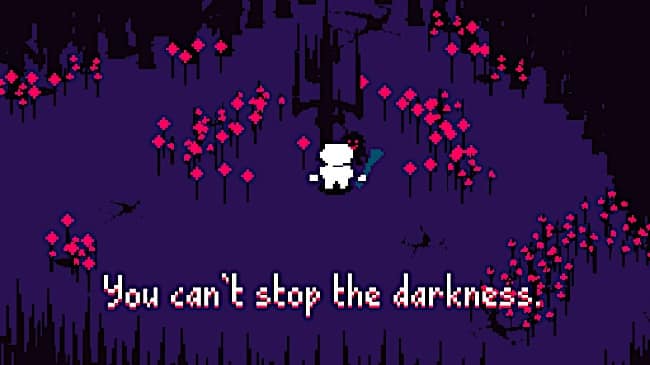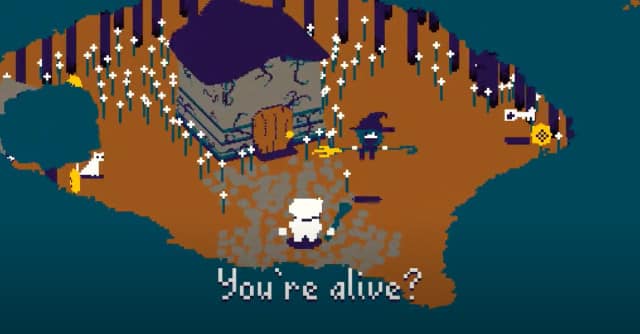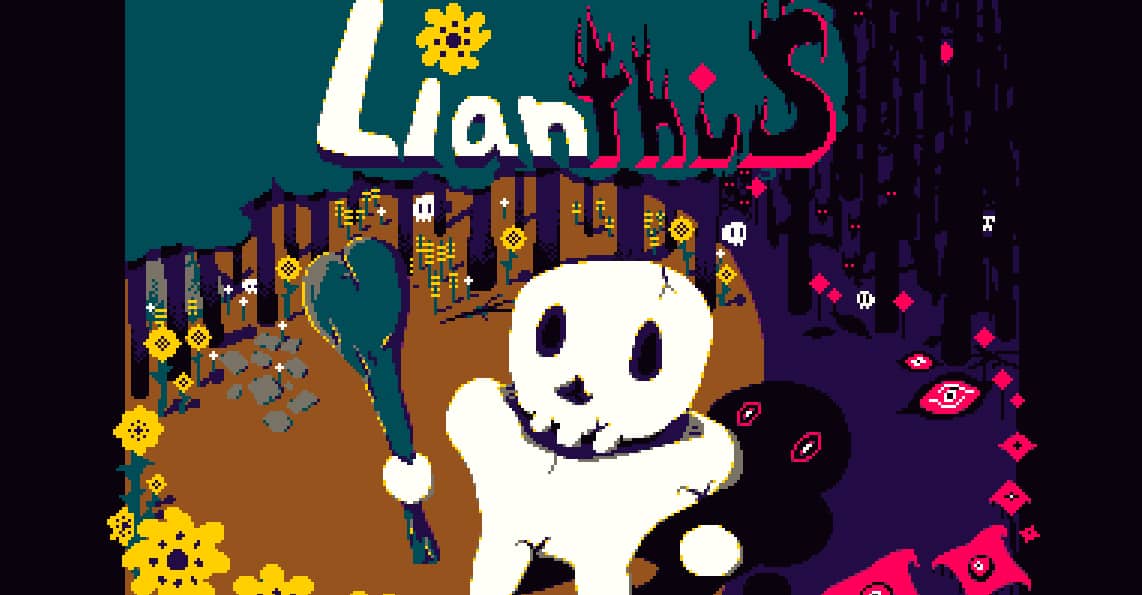In the late-‘80s adventure games I grew up with, a confusing maze section was a staple of nearly every release. From an adult perspective, these meandering paths seem to be nothing more than unnecessary padding to the main narrative, but as a kid I loved them. Space Quest II‘s alien forest seemed to be full of endless exotic dangers, and mapping out the creeping bog in Return to Zork made me feel exceedingly clever. Lianthus reminded me of that childhood obsession with mazes, featuring a beautiful 8-bit forest that swirls in strange and confusing ways. Hiding challenging boss battles below entangled branches, the free game is a stern warning to those who dare to venture into the dark.
Skele is the result of a magic spell gone wrong. A witch attempts to bring back a loved one from death, but only their skeleton is revived, with the aftereffects of the spell unleashing a terrible curse upon the forest. A dark, parallel version of the world has cracked open, with monsters creeping along every purple-black path. Skele weaves their way through the two worlds, determined to bring peace back to the woods and give meaning to their undead existence.
Lianthus is a game of two strongly contrasting styles. For most of the adventure, Skele is an explorer, hunting down keys to open up doorways and acquiring new abilities to progress further. A stronger swing of a club breaks down impassable stones, and the ability to dash lets the skeleton skip past walls of demonic fire.
Exploring is often slow, however, as the narrow pathways twist back and forth and the camera sweeps to a new position on every screen. A small compass hovers before Skele’s face, but paying attention to landmarks serves as a better form of navigation, with the witch’s twitching cat and a sullen child lying beneath a tree proving to be memorable markers. Switching back and forth between the dark world and the real one provides different paths through the forest, leading Skele deeper and deeper into the strange land.
After much exploration, stepping into an unusually wide clearing reveals the other side of the game: tough-as-nails boss battles. A shadowy wolf lunges at Skele’s brittle body, and the bony adventurer is suddenly thrust into a battle of life and death. The enemy encounters rely on pattern memorization, with each monster only vulnerable for a moment after a large attack is launched, such as a wall of fire or a skittering pack of smaller wolves. Skele has a small but intuitive range of abilities, with dashing around the arena, throwing a bone like a boomerang, and summoning an army of skeletons — all skills used to beat back the darkness.
The boss encounters are designed well, with clear attack patterns and an impressive variety of moves, but the lack of practice with the movement system meant I died many times before I defeated the beast. The controls are tight, and the move set for each of the two enemy encounters works well, but switching from slow, contemplative exploration of the forest to darting back and forth between enemy attacks takes a minute to get in the zone with. The monstrous creature that lurks at the heart of the forest is harder again, turning a recently learned move against the player in a most frustrating way.

I am of two minds about the sudden presence of brutal boss encounters when the majority of Lianthus is about quietly exploring a mysterious forest. On one hand, the abrupt introduction of combat can feel unfair: I did not fully understand how the skeleton summoning ability worked before being thrown into the final boss, and Skele has very few hitpoints to play with. The two fights are the only combat in the game, and the inclusion of some smaller encounters along the way would definitely make the difficulty curve smoother.
As part of the game’s atmosphere, however, the lack of leadup to the battles really shows how dangerous the forest is and makes Skele feel completely out of their depth. The approach reminds me of Shadow of the Colossus, along with the uncertainty of whether defeating the monsters is the right move at all. Ultimately, I think style wins over a smooth difficulty curve, but an extra hitpoint or two in the final battle would not go astray.
Lianthus is a stunningly beautiful game. Each character, tree, and structure is modeled as an 8-bit sprite, but the world is three-dimensional, most noticeable when the trees tower over Skele’s head. The effect is highly unusual and fits well with the idea of updating old-fashioned game design with new ideas.

Camera panning can be a bit of an issue though; the viewpoint zooms around every time Skele enters a new area to show off the 3D effect, but this motion also serves to disorient the player. My sense of direction has never been the best, and the swooping camera made it much trickier to remember which screen connected to where. Some of the paths are perhaps a bit too tight for navigation, too: There was one branching section near the start of the game that I did not find until much later on.
Accompanying the mysterious world perfectly is the soundtrack, with the background music shifting to suit each side of the menacing forest. Sound effects are generally minimal but used well in the boss fights, helping to telegraph every attack.
Lianthus is a strange, mysterious little world that exudes such a compelling atmosphere. The game’s difficulty spikes are harsh but are used to effectively convey a dangerous, haunted wood. If you wish to support the developer, donations can be made on its itch.io page.
Next week we will be playing Dinosaur Fossil Hunter: Prologue, a simulation game where you play as a paleontologist. The game can be downloaded from Steam. If you would like to share your thoughts, discussions will be happening in the Discord server.






Published: Sep 4, 2020 01:00 pm